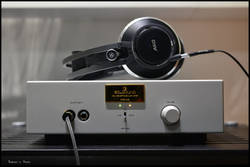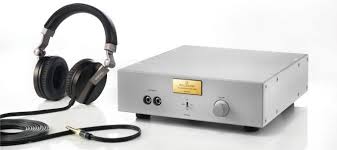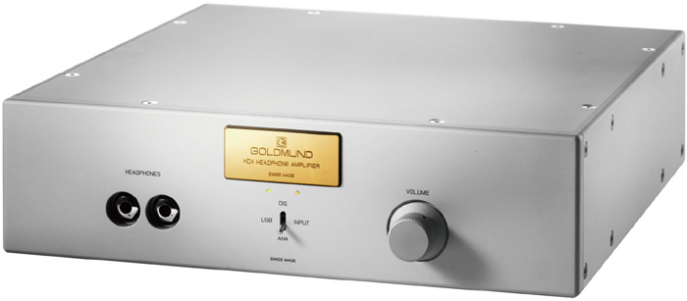When I started in the hobby in 1979 I was only familiar with companies like NAD and McIntosh in high-end audio. Back in that golden era the Japanese companies Sansui, Pioneer and Sony were working on how to better each other by building high-end receivers that are now classic collectors items. As I progressed in the hobby and became more involved with better electronics the name Goldmund starting to be frequently mentioned in the high-end journals as the luxury brand that was making reference quality electronics.
When Fred Crane called me to discuss reviewing the Goldmund Telos reference headphone amplifier with a built in DAC , my heart started racing. This would be the first time I had the opportunity to have some extended time with a Goldmund product. Opportunities to hear Goldmund products can be evasive. Goldmund is designed and built to high standards with the best available parts in Switzerland. The first thing that comes to my mind when I hear Swiss made products is precision. The Swiss have a reputation for building some of the world’s best mechanical devices and their watch making is legendary. The Swiss are also know for chocolate and alpine skiing and Goldmund electronics.
Goldmund started building luxury high-end components 35 years ago. Their amplification, speaker and turntable designs are all legendary. The Telos is their first entry into headphone amplification and digital to analogue conversion in the high-end arena. The cost of admission is $10,400 for the Telos amp/dac combination. The price makes it one of the highest offerings in its class. The company is dedicated to offering a no compromise solution for headphone users which could be used on a desktop or part of a system for people who wanted the best sound production available for headphone listening.
Design
The Telos comes in a attractive casing that weighs in at a hefty 12kg. The chassis is well constructed and offers two headphone single ended jacks in the front of the faceplate. There is a user adjustable gain switch on the front faceplate that will let you adjust the amount of gain for the headphone being used.The USB device is the audio class 2, so for Mac users there is no driver downloading required. Windows users can download the driver for the digital to analogue conversion from Goldmund’s website
The Goldmund power output of 2W per channel is robust. The amplifier is designed to recognize the different individual headphones loads and conveniently adjust the amplifier for optimal performance. The gain switch offered subtle adjustments based on which individual headphone being used during evaluation.
Listening Impressions:
The Telos is a striking design. The premium casing looked right at home in my rack. Attached to my Imac using Tidal and streaming iTunes files and high-resolution files using Aurdirvana served as the main source for the listening sessions. All cables used for this review were Nordost Blue Heaven. Once I had everything setup I started my listening session with Tidal streaming Joy Williams’s current album “Venus”. Immediately noticeable the sound coming from the unit was more analog sounding than digital. Joy’s vocal came alive and was transparent. She sounded seductive and I found myself glued to my listening chair. The sound was neither harsh nor bright; I was treated to an involving an alluring performance. The female vocal presentation ranked up there with the best reproduction that has been in my listening room.
Switching to Lucinda Williams “Where the Spirit Meets the Bone” reminded me of the live performance I attended over the summer. She was vibrant and explosive on the stage. . The guitar licks were present and drum work was special. The Telos was able to capture all the detail of the recording in a lifelike presentation and made me feel like I was back in the venue. The recording was captured with detail and transparency. The DAC used in the Telos is not a chip design. The proprietary design reminded me of the PSB and Chord units that I been listening too. The sound was more analog and less digital sounding. The Telos eliminated any sound of nasty harshness or sterile sound. The Telos was very involving and never called attention to itself.

The Telos was also a detail master. The Hifiman HE1000 soundstage is large and precise. The Telos and HE1000 were synergistic and a excellent match. The Telos was able to get the best out of the HE1000 and brought out everything the headphone had to offer. Art Pepper’s saxophone came alive on “Move” from “+11’’, Art was located in the center and each musician was in their own defined space with excellent separation. Each instrument had sufficient air and created a 3D image within the soundstage. Closing my eyes I could identify every musician in the stage easily.The Telos involvement with the music was as good as I have heard in any combination. The listening sessions sometimes went over a 10 hour period and never did I feel any distractions while listening. The music was involving and non fatiguing.
Poorly designed digital amplifiers and DAC’s can become fatiguing. The early days of digital are long gone. The converters are getting much better at inner detail and sounding more vinyl like. The Telos was also excellent at layering large-scale Classical recordings.Using the LCD X with Copland’s “The Fanfare for Common Man” was explosive and the stage had terrific layering to make the performance believable. The Telos was fast and had the necessary speed to make this recording come to life. The amplifier never clipped or ran out of steam and reproduced this demanding recording easily. The end of the Fanfare is explosive when reproduced properly. The Telos using the LCD X had my head rattling with the impact of the tympani whacks. They were fast and explosive, but still had all the texture, while never losing the impact. The Telos was dynamic reproducing this legendary Keith Johnson recording with musicality and made the performance spectacular.
The LCD X was another excellent match for the Telos. The music was transparent and bass impact was exciting and lively. “Beyond the Missouri Sky” the album collaboration between Jazz great Charlie Haden and Pat Metheny is an excellent recording to use while evaluating bass texture and acoustic guitar. The studio recording is set up with Pat Metheny in the front and Charlie Haden placed slightly behind Pat. This recording presents a challenge for amplification and DAC’s to reproduce the recordings without smear. Many amplifiers are unable to create any separation between the two performers. The Telos was able to recreate the studio performance without convoluting the performance. The musicians were as they were in the studio. I could tell Metheney was in front of Haden on “Waltz for Ruth”. The bass had texture and I could close my eyes and the imaging of Haden bass was clear and focused with his hand moving up and down the strings. The beauty of Metheney’s acoustic guitar was focused and body of his guitar was present and realistic. The Telos excelled with this recording.
The Alpha Prime can be a difficult load at times for amplifiers. The Prime using the Nordost Heimdall cable is revealing as well. The Telos was able to drive it without stress and the closed Prime delivered the performance in a musically engaging performance. Jackson Brown’s recording “The Birds of St. Marks” from his album “Standing in the Breach” is an excellent recording and the Prime and Telos made it engaging and fun to listen to. Enamored with the performance in a busy listening room I was completely entrenched in the music. The soundstage was spread-out while imaging was spot on and 3D. The Telos nailed the imaging. Focus within the soundstage was special. The performance sounded therapeutic and engaging at the same time.
The Telos was able to keep me musically engaged during its time in the listening room and sound coming form it was stellar and among the best I have heard in headphone listening, with some of the best imaging I have experienced, close to the performance levels of the Viva Egoista. There were many 10-12 hours session with the combination and none of it was boring or tiring. The ability of the Telos to engage a listener for that period of time is amazing feat rarely accomplished by electronic devices. The DAC outperformed my Sabre Dacs easily and I felt was at the same level of the Chord and PSB ladder DAC .The amp with the Hifiman HE1000 was a synergistic match and the Telos took it to another level of performance. Likewise I felt that the Audeze and Mr Speakers headphones also were at peak performance.
Is the Telos perfect? The biggest nitpick I found with the Telos was at times it would not lock the music signal and distort while using Tidal. I would have to disengage Tidal and reengage so it would lock and not distort. Goldmund told me that it is best to turn on the amplifier and then engage Tidal. That seemed to solve the issue. The other disappointment for me was that the DAC could not be used with my near field system. If you are a speaker listener and want to listen to recordings on a personal audio system, the Telos will not be a solution. The Telos is unable to drive speakers and designed as a headphone amplifier/Dac combination only. Goldmund felt that adding the output to work with speakers would compromise the performance of the Telos.
Conlusion:
The Telos by Goldmund is a magnificent product designed to be an all in one solution for headphone listeners only, designed specifically for use in desktop systems. While the price comes in at a hefty $10,400 — not inexpensive, but it also includes a world class DAC that I feel easily competes with standalone DAC’s costing $6000 or more. The Telos is a stellar performer designed by a legendary company that is committed to producing the best products without compromise and is among the finest I have heard in my listening room. The Telos just makes music, with a sound signature that is musically accurate, while the amplifier drove any headphone I used without any difficulty. The convenience of a one box solution that sounds this good is quite tempting, and for headphone lovers who want a one box solution for headphone usage would easily be satisfied with the performance that the Telos offers. Top shelf build quality and sound to die for make the Telos a strong recommendation for any enthusiast looking for world-class performance. If you can afford the price of admission this may be exactly what you’re looking for to end the upgrade merry-go-round. The Telos is stellar and performance is reference quality and one I will sadly miss.

TECHNICAL DATA POWER SUPPLY
- Nominal mains voltage: 117 V or 234 V (switchable), 50 to 60 Hz
- Mains voltage range: +/- 15 %
- 6A slow-blow fuse
- Separated ground and earth signal
- Connection between earth and ground to cancel all ground loops
INTERFACE AND FUNCTIONS
- Input selectable through front panel switch
- Binaural mode switch according to the publication “Improved Headphone Listening” of Siegfried Linkwitz
- USB device: Audio Class 2.0 (no driver required on Mac OS X as of v.10.6.4 nor on Linux, driver required only for Windows)
- 1 x Toslink Optical or Digital S/PDIF coaxial RCA 75 Ohms
- 1 x Analog RCA (Left & Right): ADC conversion for DSP correction
- RS232 Command connector
- ON/OFF power switch key
- Sample rate up to 384 kHz/Bit depth up to 32
- DSD over PCM capabilities
- Digital volume knob on front panel
- Gain adjustable for low/high sensitivity headphones.
AMPLIFIER
- Amplifier dynamic Range: > 100 dB (no weighting)
- Frequency response: +/- 0.55 dB (20 Hz – 20 kHz, unloaded)
SIZE ANDWEIGHT
- 30 W x 35 D x 10 H (cm)
- Weight: 12 kg
WARRANTY
- 3 years parts and labor
The Goldmund Telos was kindly loaned to us by Stereodesk.















Reply
Reply
Reply
Reply
Reply
Reply
Reply
Reply
Reply
Want to join discussion?
Feel free to contribute!